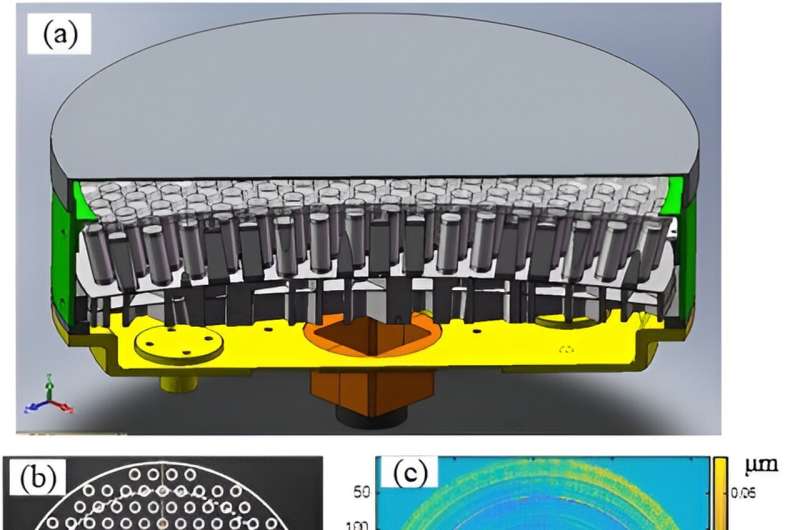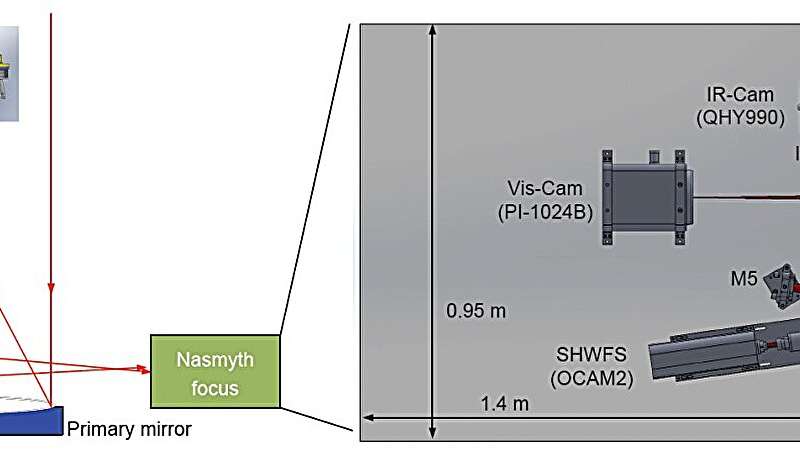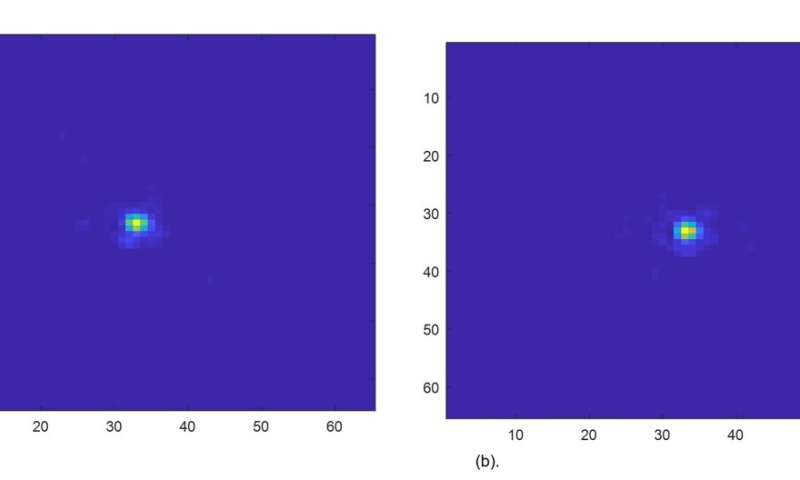This article has been reviewed according to Science X's editorial process and policies. Editors have highlighted the following attributes while ensuring the content's credibility:
fact-checked
proofread
Diffraction-limited visible imaging for large aperture telescopes

A new publication from Opto-Electronic Advances discusses diffraction-limited visible imaging for large aperture telescopes.
The deformable mirror used in adaptive optics can change its surface to instantly correct the static wavefront aberration of the optical system and atmospheric turbulence wavefront disturbance. This allows the optical system to automatically adapt to changes in the environment and maintain optimal performance. High-resolution astronomical observation, laser atmospheric transmission, and biomedical imaging all make extensive use of it.
The traditional astronomical adaptive optics system is usually installed on a platform independent of the telescope and mainly consists of special deformable mirrors, tip-tilt mirrors, wavefront sensors and relay optical elements, etc. Because there are numerous optical components passing through and a long optical route, there are issues with the system's enormous volume, significant static aberration, and low light energy usage rate.
As a result, this architecture is detrimental to measure and correct the wavefront of faint stars in high spatial and temporal frequency.
The concept of deformable secondary mirror (DSM), which entails converting the telescope's secondary mirror into a deformable mirror for wavefront correction, was first proposed by American astronomer Beckers as a means of resolving the aforementioned flaws. This concept enables the deep integration of the telescope and the adaptive optics system.
Since then, numerous well-known large-aperture ground-based astronomical observatories, including MMT, LBT, Magellan, and VLT, have successfully utilized the voice-coil deformable secondary mirror (VCDSM), showing the viability of the DSM technology.
-

The sketch of the 1.8-m adaptive telescope. -

The visible short exposure (R band) images of the star HIP49669 (2022-04-28), the images are displayed in linear scale and the peaks are normalized to 1.(a). SR=0.491, FWHM = 0.0937"; (b). SR=0.481, FWHM = 0.0953." Credit: Opto-Electronic Advances (2023). DOI: 10.29026/oea.2023.230039
At the same time, the Institute of Optics and Electronics started the research of piezoelectric DSM (PDSM) technology. The researchers then developed the first 73-unit PDSM prototype, which was successfully installed on a 1.8-meter telescope for on-sky observation in 2016.
It is demonstrated that the PDSM technology is practical for astronomical observation. In comparison to VCDSM, PDSM is more compact and does not need any additional cooling systems, internal control electronics or actuator position sensors. This article introduces the new 241-unit PDSM developed by the Institute of Optics and Electronics and its application on the 1.8-m adaptive telescope of Lijiang Observatory, which is supported by the key project of the National Natural Science Foundation of China.
PDSM-241 is equipped with a mirror of 320 mm diameter made of quartz, and the clear aperture of it is about 270 mm and is driven by 241 piezoelectric actuators to change its surface for wavefront correction. The self-corrected aberration of PDSM-241 is about 10 nm.
The structure of the Lijiang 1.8-m adaptive telescope involves a combined wavefront correction device that combines the PDSM-241 and Hexapod can achieve both tracking and high-order wavefront aberration correction with a large stroke and great precision. The 1.8-meter telescope's primary mirror reflects the stellar beam that has been distorted by atmospheric turbulence, which is then corrected for tip-tilt and high-order wavefront aberration by the PDSM-241 and Hexapod. Finally, the tertiary mirror reflects the beam to the wavefront sensor and high-resolution imaging cameras at the Nasmyth focus.
The Lijiang 1.8-m adaptive telescope acquired high-resolution images of stars using PDSM-241's efficient closed-loop correction. Images from the visible R band (central wavelength 640 nm) are shown, the imaging resolution of which achieve 1.25 times of the diffraction limit and the imaging Strehl ratios (SR) close to 0.5.
Aiming to meet the needs of high integration and high resolution of large aperture optical telescopes, this research has made impressive strides in the development of high-performance piezoelectric deformable secondary mirrors and astronomical observation applications. This further simplifies the structure of large-aperture high-resolution optical telescopes and improves the imaging resolution, which has significant application value in astronomy.
More information: Youming Guo et al, High-resolution visible imaging with piezoelectric deformable secondary mirror: experimental results at the 1.8-m adaptive telescope, Opto-Electronic Advances (2023). DOI: 10.29026/oea.2023.230039
Provided by Compuscript Ltd




















